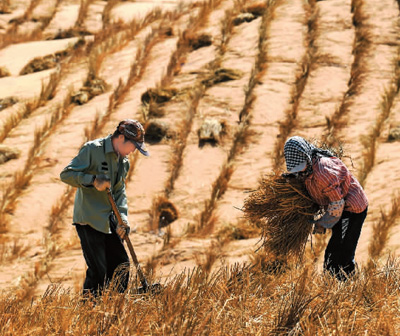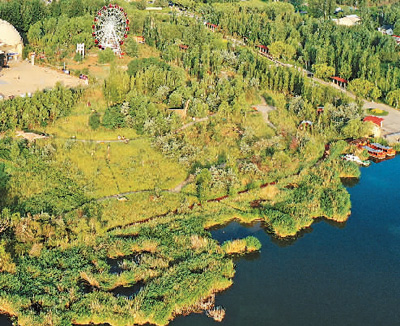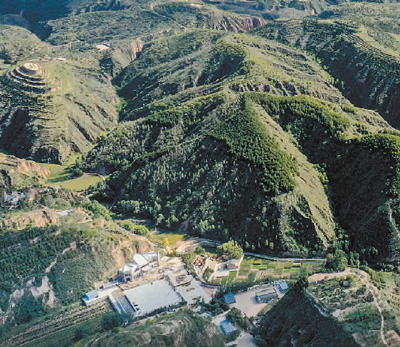China successfully halts expanding desertification thanks to decades of steadfast efforts
China has successfully halted the expanding desertification in its northwestern region, with the total land area changing into desert and sand shrinking by an average of 2,424 square kilometers and 1,980 square kilometers per year, respectively.

Desertification control workers construct straw checkerboard barriers in the Tengger Desert, northwest China's Ningxia Hui Autonomous Region. [Xinhua/Feng Kaihua]
The country has achieved a historic transformation, with its shift from a state of rising desertification to a growing green expanse of land, having since become a successful example of global desertification control.
Over the past 70 years, China has made continuous efforts through afforestation in order to better tame desertification, described as the "cancer of the Earth," according to Lu Qi, director of the Institute of Desertification Studies under the Chinese Academy of Forestry.
The country began to curb desertification nationwide in the early 1950s and set up a leading group on desertification control to coordinate its efforts.
When the construction of the Baotou-Lanzhou Railway, a desert railway that passes through lofty sand-shifting dunes in the Tengger Desert in Zhongwei city of northwest China's Ningxia Hui Autonomous Region, was completed in 1958, straw checkerboard barriers were adopted to prevent the railway from being buried by the sand. The straw checkerboard barrier method has proven effective in fighting desertification and has become well-known around the world.

Photo shows a scenic area in the Kubuqi Desert, north China's Inner Mongolia Autonomous Region. [Xinhua/Jin Liangkuai]
In addition to exploring technological means to curb desertification, China has also carried out key ecological projects to facilitate desertification prevention and control efforts. In 1978, the State Council approved the Three-North Shelterbelt Forest Program (TSFP), which consisted of afforestation efforts in the northwest, north and northeast regions of China. Since 2000, the country has launched key ecological projects covering a variety of tasks, including transforming farmland back into forests and grasslands as well as controlling the source of sandstorms around the municipalities of Beijing and Tianjin.
China is the first country in the world to issue a law on the prevention and control of desertification, building a green barrier in the legal system, according to Lu.
From 2016 to 2020, China completed desertification control work on almost 11 million hectares of land. In 2021, the country planted 3.6 million hectares of trees, improved the ecology of more than 3 million hectares of grassland, and controlled 1.44 million hectares of sandy and rocky desertification land, according to a bulletin on afforestation in China during 2021 as recently released by the country.
Some exemplary individuals have made great contributions in desertification control across China.
In 1981, six local villagers took a contract and established the Babusha Forest Farm to curb desertification in Babusha located on the southern edge of the Tengger Desert in Gulang county, Wuwei city of northwest China's Gansu Province, where farmland and villages had long been plagued by desertification.

Photo shows a village tucked away in lush green mountains in Yulin city, northwest China's Shaanxi Province. [Xinhua/Tao Ming]
After years of largescale efforts, a 42,000-mu (2,800-hectare) forest was eventually able to spring up. By the time the desert had turned green, the hair of the six villagers had become white with age. Therefore, they agreed that each family would contribute one of their family members to take over the desertification control work going forward.
So far, three generations of workers at the Babusha Forest Farm have managed to dedicate themselves to turning the desert into an oasis. More than 200,000 mu of forests have been planted, and the desert areas near Babusha are now tamed.
Shi Guangyin, a farmer in Dingbian county located on the edges of the Maowusu Desert, Yulin city, northwest China's Shaanxi Province, is another shining example. On June 29, 2021, Shi, also a veteran Party member, received the July 1 Medal, the highest honor in the Party, for his outstanding contributions to desertification control over the past decades.
Shi began to plant trees to curb desertification in 1968. He entered into a contract with the local government for the desertification control of 3,000 mu of sandy land in 1984. Over the years, a group of local people led by Shi have braved innumerable trials and hardships, planting and keeping alive more than 53 million trees on 250,000 mu of barren sand and alkali beaches, finally achieving the goal of building a "green Great Wall" on the edge of the Maowusu Desert.
China's desertification efforts have also reaped economic benefits for the country. In the Kubuqi Desert in Ordos city, north China's Inner Mongolia Autonomous Region, known as the "sea of death," the sands once seemed impossible to control, but the local government has managed to coordinate desertification efforts with the development of photovoltaic power projects by leveraging the desert's rich solar resources.
At present, 53 percent of the desert is now covered by vegetation, with the level of precipitation having undergone a sharp rise there, while the number of sandy days dropping significantly as a result.
At an industrial base in the desert, pieces of photovoltaic panels can be seen neatly laid out one after another, with potatoes and other crops growing underneath in the shade of the panels.
In 2014, the United Nations Environment Program (UNEP) announced that the desert is an ecological economy demonstration zone.
With the ecological environment of Kubuqi having significantly improved, the local tourism has received a major boost in the area, bringing wealth to residents in the locality.
























